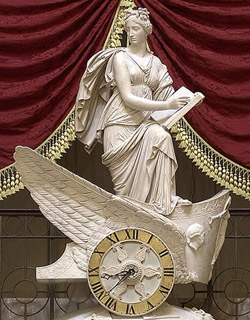Clio
From NovaRoma
(Difference between revisions)
(added pocture) |
|||
| (4 intermediate revisions by 3 users not shown) | |||
| Line 1: | Line 1: | ||
| − | [[Image:clio us house.jpg| frame| right|]] | + | [[Image:clio us house.jpg|frame|right|The Greek muse, Clio, stands on top of the “Car of History” |
| + | overlooking the Old House Chamber (Statuary Hall). Marble, Carlo Franzoni, 1819, courtesy of Architect of the Capitol. | ||
| + | Image from the public domain website of the [http://www.aoc.gov/cc/art/car_of_history.cfm Architect of the Capitol].]] | ||
| − | + | Clio ('''Kleio''' in Greek) is the goddess of history, the "proclaimer", the "giver of fame", and is the patroness of history and historical poetry. She is the second of the nine [[Muses]] (''Mousai'' or ''Mneiai'', and ''Musae'' or ''Caménae'' in [[Latin]]), the goddesses of cultural production. | |
| − | + | ||
| − | + | Clio, the muse of history, can be said to have had a hand in the creation of many of Rome's [[core narrative]]s. | |
| − | + | ||
| + | [[Category:Roman Gods]] | ||
Latest revision as of 17:53, 20 November 2012

The Greek muse, Clio, stands on top of the “Car of History” overlooking the Old House Chamber (Statuary Hall). Marble, Carlo Franzoni, 1819, courtesy of Architect of the Capitol. Image from the public domain website of the Architect of the Capitol.
Clio (Kleio in Greek) is the goddess of history, the "proclaimer", the "giver of fame", and is the patroness of history and historical poetry. She is the second of the nine Muses (Mousai or Mneiai, and Musae or Caménae in Latin), the goddesses of cultural production.
Clio, the muse of history, can be said to have had a hand in the creation of many of Rome's core narratives.